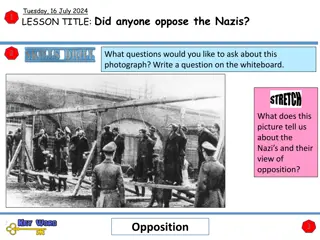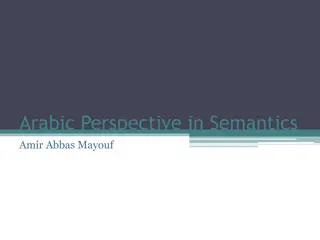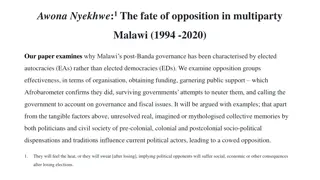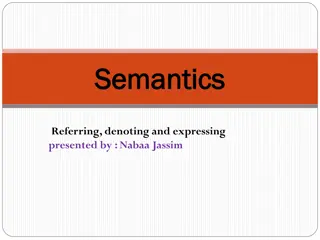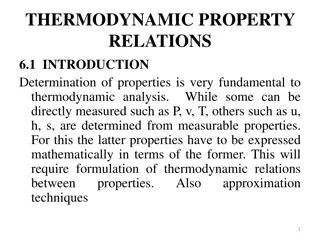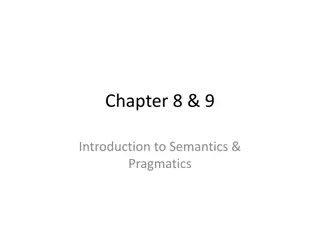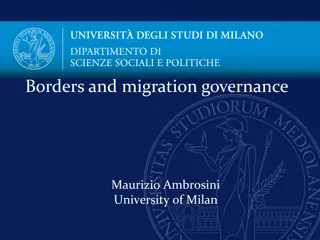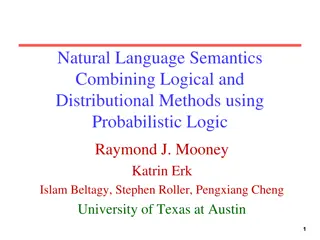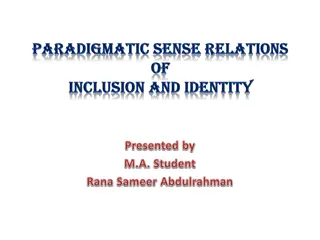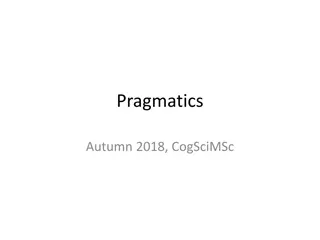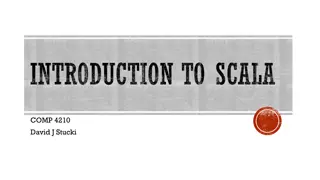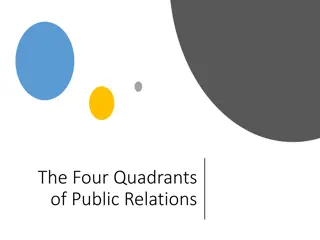Semantics and Paradigmatic Relations of Exclusion and Opposition
The presentation explores the concepts of incompatibility, co-taxonymy, and opposition in semantics. It delves into how certain terms exclude others within a set and the various forms of opposition such as complementaries and antonymy. Examples like "Women, Queen, Mother, Servant, Teacher" illustrate these linguistic relationships. The relationship between parts and wholes, as well as binary opposites and inherentness, is also discussed. Additionally, the presentation highlights the importance of understanding these semantic constructs in categorizing experiences and language.
Download Presentation

Please find below an Image/Link to download the presentation.
The content on the website is provided AS IS for your information and personal use only. It may not be sold, licensed, or shared on other websites without obtaining consent from the author. Download presentation by click this link. If you encounter any issues during the download, it is possible that the publisher has removed the file from their server.
E N D
Presentation Transcript
Semantics Paradigmatic relations of exclusion and opposition Represented by: Shahad Osama
2 Outlines of the presentation 1. Incompatibility and co- taxonymy 1.1 Incompatibility 1.2 Co- taxonymy 1.3 Co- meronymy 2. Opposition 2.1 Complementaries 2.2 Antonymy: 2.3 Reversives 2.4 Converses 2.5 Markedness 2.6 Polarity
3 1-Incompatibility and co- taxonymy 1-1 Incompatibility: It refers to sets of items where the choice of one item excludes the use of all the other items from that set.(Crystal: 2003) Incompatibility: indicates the following: -A Superordinate(hypernym) has more than one hyponym -The resultant hyponyms (set of terms) related to all the others by relation of incompatibility -Incompatibles: are terms which donate classes which share no members.
4 FOR EXAMPLE: Women Queen Mother Servant Teacher
5 1-2 Co- taxonymy -it s the corresponding conceptual relations. Its prototypical cases that should be mutually exclusive (can not occur at the same time) - It s a vital mode of categorization of experience. - E.g. For gender pay gap protest in France, Women came from all walks of life .. Doctors, teacher, solicitors, housewives, student, prostitutes. -
6 1-3 Co- meronymy Meronymy: is the relationship which obtains between parts and wholes (Crystal: 2003) Co- meronyms: are set of meronyms Co- meronymys: also indicate a relation of exclusion E.g. Car (Y) Tire (Z) Door (X) Mirror (A)
7 The boundaries of parts often display a degree of Vagueness which destroys the strict logical relationship: E.g. Arm Upper arm Lower arm Elbow
8 2- Opposites: Consist of: A-Binary: Two members of opposites B-Inherentness :its notaccidental (single-deckers: double-deckers) (Tea: Coffee) But its inherent binarity (Up/Down)
9 2- Opposites C. Patency: The pair should be patent ( Yesterday Tomorrow) rather than latent ( Monday Wednesday ) Tuesday Today
10 2.1 Complementaries Constitute a very basic form of oppositeness (dead: alive/ obey: disobey) Have no possibility of setting on the fence Rarely, have a possibility of exceptional states(abnormalities/ irregularities) fallen between a pair: Dead: Zombie: alive
11 2.2 Antonymy: is classified into 3 groups: 2.2.1: Polar antonyms 2.2.2: Equipollent antonyms 2.2.3 Overlapping antonyms
12 2.2.1 Polar antonyms 2.2.1 Polar antonyms : Long: short/ fast: slow/ deep: shallow etc. The features of this group are as follows: A. Both terms are fully gradable unlike complementariness Very long: very short They occur in the comparative and superlative degree Longer, longest: shorter, shortest They indicate degrees of some objects and unidimensional physical property They are incompatibilities, but not complementaries Comparative forms stand in a converse relationship: (John is longer than Marry) entails that (Marry is shorter than John)
13 2.2.1 Polar antonyms The comparative forms of both terms are impartial (have no specific average) : (John is longer than Marry) does not denote that Marry is short Impartial questions can be used: How .. Is he/she/it ? How long is he?
14 2.2.2 Equipollent antonyms 2.2.2 Equipollent antonyms : (hot: cold) ( bitter: sweet) etc. Do not imply impartiality have a specific average Unlike the polar antonyms: Polar antonyms: e.g. John is longer than Marry, but he is shorter than Tome Equipollent antonyms: This coffee is hot, but its colder than that one
15 2.2.3 Overlapping antonyms: 2.2.3 Overlapping antonyms: One member of the pair yields an impartial comparative and the other one a committed comparative. We can t say (John is an excellent tennis player, but he is worse than Tom) because if someone is excellent, he can t be called (worse) We can say ( John is a pretty useless tennis player, but he s better than Tome. E.g. (John is polite, but he is ruder than Tom) is wrong. E.g. (Marry is rude, but she is more polite than her friend) is right.
16 2.3 Reversives Reversives belong to a broader category of directional opposites, which include a straightforward directions. For example: up: down, forwards: backwards, into: out of, north: south Reversives could denote a change in opposite directions between two states: tie: untie, dress: undress .etc..
17 2.4 Converses Converses often considered to be a subtype of directional opposites, sometimes they are considered to be a type of synonym E.g. (above: below) A Converses may be described as two-place (A is above B/ B is below A) B and three-place (A is above B and C/ C is below B and A) C Converses could refer to a relationship from opposite points of view. - E.g. ( Parent: child ) - Bill is Tom s parent/ Tome is Bill s child . -
18 2.5 Markedness This notion is often applied to pairs of opposites: One term is designated as the marked term and the other as unmarked term of the opposition Lyons (1977) distinguished three major conceptions of Markedness: A. Morphological Markedness: happy: unhappy, kind: unkind B. Distributional Markedness: ( one member of a pair has a common usage (unmarked) , unlike the other member ( marked) E.g. long (unmarked): short (marked ) E.g. this one is ten meters long/ what is its length?/ How long is it ? C. Semantic markedness: The meaning of the term is what is common to the two terms of the composition. E.g. lion (unmarked): lioness (marked)
19 2.6 Polarity It s a notion of opposition, whereby terms are designed as positive and negative. The main ways of usage are as follows: A. Morphological polarity: true: untrue B. Logical polarity: John is not (not) fat / indicates that John is fat C. Privative polarity: alive: dead, married: single D. Evaluative polarity: kind: cruel, safe: danger
20 References Cruse, A.(2000). Meaning in Language: An Introduction to Semantics and Pragmatics. Oxford. Oxford University Press. Crystal, D. (2003). A Dictionary of Linguistics & Phonetics. Blackwell publishing Ltd.
21 Thank you..



